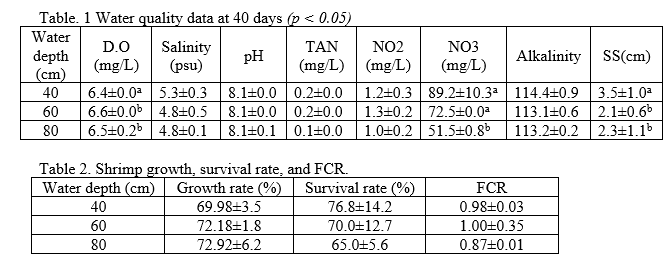EFFECT OF WATER DEPTH ON Litopenaeus vannamei PRODUCTION AND WATER QUALITY
In recent years, researchers and several commercial operators have proposed using relatively shallow tanks to rear shrimp. Such systems can be stacked several tanks high, thereby conserving floor space in a building. However, there is a risk that aeration may be less efficient in shallow tanks. Furthermore, shrimp are more concentrated in shallow tanks and therefore nutrients may likewise become more concentrated. The purpose of this project was to compare various water depths with regard to shrimp production and water quality impacts.
A research trial was conducted using eight, 18 m2 HDPE-lined tanks equipped with Venturi-style aeration systems. The tanks were stocked at 160 shrimp/m2 (mean body weight 0.2 g) and randomly assigned to one of three treatments dictated by water depth: 40 cm, 60 cm, and 80 cm; each treatment had two replicate tanks. During the experiment, the postlarvae were fed at 8% biomass of feed 4 times per day. The DO, pH, salinity, and temperature were monitored daily and ammonia, nitrite, nitrate, alkalinity, and solids concentration were measured weekly. At the end of the trial shrimp FCR, growth rate, and survival were calculated. All data were expressed as the mean ± SD. Significant differences among different treatments were analysed using a SPSS 17.0. After 40 days, water quality parameters measured during the experiment are shown in Table 1, and shrimp production data are presented in Table 2.
The project demonstrates that DO and nitrate concentrations were significantly impacted by water depth, but no noticeable differences in shrimp production were found. This indicates that perhaps with special consideration to water quality, shallow tanks with Venturi-driven aeration may be a feasible option for shrimp production.
